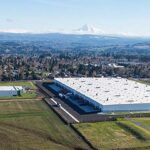A manufacturing hub springs up on the outskirts of the Portland metropolitan area.
A strong economy has helped populate a business park in Gresham, which just last year stood mostly empty.
The city has seen 1.5 million square feet of industrial construction since 2016, says economic development director Shannon Stadey. “There’s been a tremendous amount of activity.”
Most of the development centers around Gresham Vista Business Park, where developer Specht Properties completed two complexes this year totaling 1.3 million square feet. A medical equipment supplier, Medline, signed a lease for a 300,000 square-foot space. Cargill, a food distributor and supplier, moved into another, smaller location.
Related Story: Gresham leaders optimistic about development potential
Other leases have been signed, Stadey said, but she couldn’t discuss the details yet, citing non-disclosure agreements.
Gresham has managed to attract companies with no special tax breaks outside the state enterprise zone program and a property tax abatement for very large industrial investment thanks to its fast-track development timeline, she says.
Gresham promises developers a 66-day review, by far the fastest in the state. “We’ve had really positive feedback from the development community. What we understand is time is money,” says Stadey.
The most intriguing addition to the business park is a 60,000 square-foot synthetic diamond factory owned by Element Six, a subsidiary of DeBeers Group. The facility under construction will begin its first production run in 2020, and is expected to produce 500,000 rough carats by the end of that year. It will employ 60 workers, half of whom will be focused on research and development, and engineering.
“It’s the exact type of company we’ve been hoping to locate at Gresham Vista,” Stadey says. “The vision has been to intentionally create that business park as a high-tech campus.”
Element Six chose Gresham of all places for its access to cheap electricity and qualified employees, says Steve Coe, general manager of Lightbox Jewelry, the company that will retail the diamonds. Making a diamond requires an uninterrupted deluge of electricity for two weeks at a time. Coe says it’s by far the largest variable cost in the manufacturing process.
The synthetic diamonds are an experimental product that the U.K.-headquartered company is betting will appeal to American customers. At $200 to $1,000, the lab diamonds will come at a lower price point than natural ones. Coe says they’re ideal for “more everyday gifting occasions.”
“It’s just starting out,” Coe says. “But I think there will be increased interest.”
“The vision has been to intentionally create that business park as a high-tech campus.”
— Shannon Stadey
As the Gresham continues to grow, it’s facing pressures common to other rapidly developing Oregon cities. Like other locales in the Portland metro region, it desperately needs affordable housing for the people who aren’t handing out diamonds every day. Eventually the industrial land will run out, Stadey says, so the city is looking at ways to retrofit old industrial properties for reuse.
But for now, the booming economy and momentum from the recent projects should continue to catalyze new development. “So many manufacturing companies held onto their money for quite some time,” Stadey says. They were waiting for the right site, right capital markets. Now they’re seeing all the stars aligning.”
To subscribe to Oregon Business, click here.





